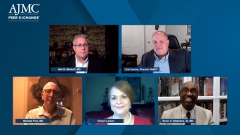
Future of Medical and Pharmacy Benefit Integration
Episodes in this series

Closing thoughts on the challenges and benefit of implementing an integrated cross-benefit management system and the need for transparency in communication among all involved parties.
Neil B. Minkoff, MD: That is probably the best way for us to try to pull together and wrap this up as an overview. I want to thank all 4 of my panelists here today for a rich discussion and evaluation of all the challenges and benefits of products going through the medical benefit, the pharmacy benefit, what integration would look like, and all of the different tangents we managed to cover in the meantime. I’d like to thank all of you for participating and get 1 closing thought from each of you. Dr Cannon, please lead us off with your final word.
Eric Cannon, PharmD, FAMCP: Thank you. We’ve had a lot of dynamic conversation today about a lot of different things. If I was to sum up what’s key, Cheryl brought it up when she talked about transparency. As you evaluate pharmacy benefit vs medical benefit, if you factor in those medical costs without transparency into each one of those data points, it’s difficult to make decisions. Once you have transparency in that, we’re ultimately all clinicians, so we’re all focused on delivering the best care we possibly can for our patients and provide the appropriate level of information. Most organizations across the country will come together to make sound decisions and deliver good care for their patients.
Neil B. Minkoff, MD: Dr Fine?
Michael Fine, MD: There was a famous quality management expert called Edwards Deming, and he improved the quality of the Japanese auto manufacturing system as an expert. His basic argument was that every system is developed to produce exactly the results it does. If you want to achieve different results, you can’t do it without changing the system, and that’s the problem here. We somehow have to have a system where things run more integrated and more smoothly, and until we have things like that, we certainly illustrated all the problems. We’ve managed to achieve some of the workaround solutions, but we won’t have a true integration until we modify the system.
Neil B. Minkoff, MD: Ms Larson?
Cheryl Larson: Right now, the medical benefit is a black hole, and pharmacy is often driven by rebates, and employers are frustrated. We want physicians to get back to doing what they’re supposed to do, and everyone needs to be reminded that employers only have so much to spend on health care. We do not have an open checkbook. We also need to move into contracting that is value-based and outcomes-based, and we want intermediaries to stop adding waste to the cost of health care and drug treatment. Employers care about their employees and plan members, and as fiduciaries, we are responsible for bringing the best benefits, the best health care, and the best drug treatment to our employees and families. It’s our fiduciary responsibility, so if everybody is adding to that cost, are we fulfilling our fiduciary responsibility? I enjoyed our fellow speakers, how thoughtful you are, and how much you care about patients and their family members. It’s a reminder to all of us that we need to collaborate; we need to work together.
Neil B. Minkoff, MD: And Dr Stephens?
Kevin U. Stephens, Sr, MD: I’d like to take a bit from everybody. The transparency is an important component, but communication is equally important. We all have to communicate with each other and be transparent in our communication. To what Michael said, the system is important because inherent in certain systems are problems that we have to account for. If we have a bad system, there are going to be bad outcomes. The last thing I’d like to say is about flexibility. With the availability of technology today, we have the ability. The technology, I can remember a long time ago; what we have on our desktop now used to be a whole room of computers. We can do so much on our phone today that it’s a walking library.
Our ability to customize health care based upon the individual and expand it from the individual to the community that encompasses that person, whether it’s an employer, and our ability to go to the medical community to look at geographic considerations, such as how far it is to the provider or to the hospital, those kind of things, as well as our ability to integrate the whole system and to have a collaborative, transparent structured systemic plan—that’s utopia. We’re nowhere near there, but COVID-19 [coronavirus disease 2019] is pushing us toward using more technology, communicating more, and thinking outside, people say outside the box, but I like hamburgers, so I say outside the bun. We have to start thinking in different ways about how we are going to solve this problem using some of the technology we have.
Neil B. Minkoff, MD: I would certainly love to thank all of you involved once again, many times over, for a robust conversation. There is a lot for us to think about, and there was a lot of good information about the different benefit structures and what those mean to our different stakeholders in the industry. I also want to thank everybody in the viewing audience for participating and being a part of this panel discussion. Thanks once again, and I speak on behalf of our panelists that we all hope that you found this to be informative, useful, and interesting. Thanks very much on behalf of the American Journal of Managed Care® for being part of our panel. Thank you.
Newsletter
Stay ahead of policy, cost, and value—subscribe to AJMC for expert insights at the intersection of clinical care and health economics.

























































